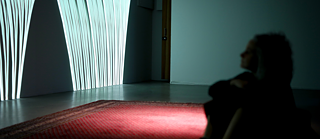Interview with Colette Sadler
Moving Pictures
Berlin-based choreographer Colette Sadler, presented ARK 1: Towards a Future Archaeology — a work comprised of video, sculptures and a performance danced by Leah Marojevic as part of the exhibition Growing Body of Evidence at Goethe Morph* Iceland. The works presented captured questions about possible futures - with virtual realities, wax portraits and 3D printed sculptures as central elements of the exhibiton. Colette is a choreographer who extends her practice through other mediums, such as video art and installations, working in a precise and insightful manner. We talked about her ways of working as well as her inspirations and engagement with the future.
by Sóley Frostadottir
Could you tell me about your background in the arts. Where are you coming from?
I come from Glasgow and from the age of fourteen I started taking classes at the Scottish Ballet every day. I was also in a contemporary youth company. When I was sixteen I moved to London to study ballet, but I wanted to study contemporary dance so I decided to study at the Laban centre in London and after graduation, I was picked for their dance company: Transitions dance company, and we toured the world. I was trained as a dancer and worked as a dancer for about five years, and then I decided to begin to make my own work. It just happened that the process of making work became so all encompassing, that there wasn‘t really time to dance for other people as well.
How would you describe your practice?
I also have a solo practice which I would like to return to next year. I made the decision to not dance in my own work. But, if I work with myself it‘s a completely different process and more personal in a way. I miss the solo practice, but I am busy with the other practice and touring. When choreographing with other dancers, I work with improvisation a lot, so I have a set of tools or generators that will generate the idea which the dancers produce material from. I will then choreograph it. I‘m specific in the choreographic style, there is a signature on it.
Do you work with the same dancers usually?
I started to work with Leah Marojevic who dances in ARK 1 a few years ago, creating a solo for her. It was easier to make a concept for one body than for five at that time. We wanted to work on another piece together, so we went on to collaborate some more.Do personal experiences merge with your artistic research?
I work a lot with my unconscious, the back of my brain. I wouldn‘t say the work was about something personal, but the piece reflects on my experiences, so I would say that for me the works are deeply personal, but it‘s not visible."I think of choreography as making pictures.
I constantly make pictures, and then they move."
It seems there‘s something abstract that surrounds the unconscious and the personal in the work.
Yes, I like to work with structures and choreography for me is about musicality, like in ARK 1, it‘s the little movements. My works are not about feeling, rather about time and rhythm in space. The visual arts were more interesting to me than theatre. So in that sense abstraction is more interesting to me. I think of choreography as making pictures. I constantly make pictures, and then they move.
There is speech in ARK 1, but the echo made it rather difficult to understand, so the viewer is left with a sense of the fragmented spoken word. I‘m curious about the use of language and about the role of science fiction in the work.
We started with learning from the future, reimagining the body, as a biotech. That was the first piece that we made together with Leah. A work we‘re still touring five years later. It might sound banal, but I‘m interested in time, and it‘s a big subject in the work that I‘m doing—whether it‘s about time as rhythm in composition, slowness, past or future. Time is articulated in different ways across the different pieces. In a way ARK 1 is about the eternal, it‘s about beyond-human. Science fiction is a way for me to talk about beyond-human. So science fiction is a good holding structure for a clear dramaturgy. We built Body A, and Body A is in an abstract landscape. Science fiction allows a body to exist in another way.
Would you say there is hope in ARK 1?
I think so, it‘s apocalyptic and fairly dark in the sense that it starts in a crisis, but for me ARK 1 is hopeful because somebody wanted to make this memory of human existence and send it out in the hope that someone would find it. So there is hope in the future human or whatever civilization. I do find it hopeful that you would preserve a fragment, hoping that it will arrive somewhere. But, I don‘t like this idea that humans would go and colonize the next planet and do even worse. It‘s more of an open question, I think. If that fragment were detected it would be historical, this crisis would become a point in history.



